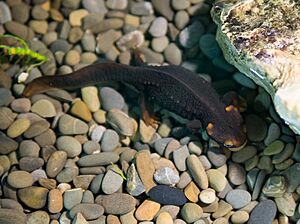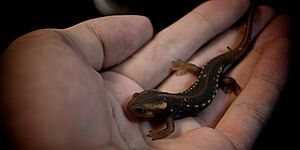Tylototriton verrucosus facts for kids
Quick facts for kids Tylototriton verrucosus |
|
|---|---|
 |
|
 |
|
| Tylototriton verrucosus in a person's hand showing its size | |
| Conservation status | |
| Scientific classification | |
| Genus: |
Tylototriton
|
| Species: |
verrucosus
|
The Himalayan newt (scientific name: Tylotriton verrucosus) is a special type of newt. It lives in parts of the Indian subcontinent and Southeast Asia. People also call it the crocodile newt, Himalayan salamander, or red knobby newt because of its unique look.
Contents
About the Himalayan Newt
This newt can grow up to 20 cm (7.9 in) long. Its tongue is small and can move freely on the sides. Inside its mouth, it has two rows of teeth on the roof that meet at the front. The newt's skull has a thick, bony arch, which is common in all salamanders.
What It Looks Like
The Himalayan newt has a wide head with a short snout. Its head has three clear bony ridges, one in the middle and two on the sides at the back. Its body is about 3 to 3.5 times longer than its head.
Instead of a crest along its back, it has a noticeable ridge with a series of bumps. These bumps are formed from its backbone. Along its sides, it has 15 or 16 knob-like glands. The last three of these glands are located behind its legs.
Its legs are a medium length. Its fingers and toes are slightly flattened and have some webbing. The tail is at least as long as its head and body. It is flattened, which helps the newt swim well. The tail has an upper and lower ridge that meet at the tip.
The newt's skin feels rough. It has large glands near its ears called parotoid glands. There is also a strong fold under its chin. The entire newt is a dark brownish-black color. Its lips, snout, chin, throat, and the underside of its limbs are a bit lighter. The bottom edge of its tail is a bright orange-yellow.
What They Eat
Himalayan newts are carnivores, meaning they eat other animals. They enjoy a diet of spiders, worms, millipedes, scorpions, molluscs (like snails), and many types of insects.
Reproduction and Life Cycle
During the breeding season, which usually happens in May and June, male and female newts show different behaviors. Courtship and mating take place at night. Like many salamanders, the male will move around the female, bending and curving its tail to attract her.
Where They Live
The T. verrucosus newt is found in the mountains of Yunnan (China), the Kakhyen Hills, Sikkim (India), Manipur (India), and Northern Myanmar.
Efforts are being made to protect its home in the Darjeeling area of India, where many newts breed. In Thailand, this newt is only known from Doi Chang in Chiang Rai Province. Other newt groups found in Northern and Northeastern Thailand, as well as in Laos and Vietnam, were identified as new species in 2013 and 2015. These include T. anguliceps, T. panhai, and T. uyenoi.


